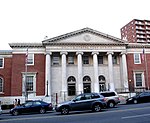Flushing International High School
AC with 0 elementsEducation reformFlushing, QueensInternational high schoolsInternational schools in the United States ... and 5 more
New York City school stubsPublic high schools in Queens, New YorkQueens, New York building and structure stubsSmall schools movementUse mdy dates from October 2020

Flushing International High School is a New York City public high school that opened in September 2004 in Flushing, New York. Students come from over 30 different countries and speak over twenty different native languages. Flushing International is a NYC School Empowerment School in District 25.
Excerpt from the Wikipedia article Flushing International High School (License: CC BY-SA 3.0, Authors, Images).Flushing International High School
Barclay Avenue, New York Queens
Geographical coordinates (GPS) Address Nearby Places Show on map
Geographical coordinates (GPS)
| Latitude | Longitude |
|---|---|
| N 40.759 ° | E -73.8238 ° |
Address
Barclay Avenue 142-30
11355 New York, Queens
New York, United States
Open on Google Maps







